| By: Paul S. Cilwa | Page Views: 3060 | ||
| The Universe is about 14 billion years old; and it left evidence of its evolution each of those years. | |||
As long as Man has had language, we have talked about where we came from and how we got here. It may be part of our urge to forget our Divine origins; it may simply be the result of an overactive imagination, or having to live (most of our history) without cable TV. Whatever the reason, many of our creation myths have been incredibly rich, but in the end they probably reveal more about ourselves than the actual origin of the Earth or the Human species..
In this section of the ONA web site, we are going to explore the origins of the Human Race. This exploration may well take us places we never expected to go. Nevertheless, we are going to make the journey because only in understanding our true natures, can we achieve Wholeness.
Because this journey is going to go to some unexpected places, and because it is going to bypass some expected places, it is important that we take a few moments to reassess what we actually know to be true. You may be surprised to discover how much science actually knows about our origins…and by how much is not known.
The Big Bang

Most people know that science believes
that the Universe began
with a big bang
. Most people do not know what is meant by
this, other than some kind of explosion.
First of all, the Big Bang is not known fact. It is still a theory,
too new to claim itself as proven
, Still, like any scientific
theory, it has made predictions, and, so far, all the predictions have been
found to be true. That is a pretty powerful evidence that it is so.
According to the theory, our four-dimensional Universe (height, width, depth, and time) came into existence out of a containing, fifth-dimensional continuum, approximately 15 billion years ago. From our point of view, all the energy currently present in the Universe bubbled into existence in a single, incredibly small (but incredibly hot!) point. That point was this whole Universe. Instantly, this point (the Universe) began to expand, at amazing speed, until it reached its present size—and it is still expanding.
As it expanded, the Universe cooled, its energy spread out over a greater area. When this happened, especially in the few few seconds of expansion, much of the energy was changed into matter. (Einstein explained, and the atom bomb proved, that matter and energy are really the same thing.) The first matter was immense clouds of matter's simplest form: Hydrogen gas.
This cooling, it was predicted, would produce a background noise of radio waves coming evenly from every direction. This background noise was verified by the Cosmic Background Explorer (COBE) satellite in 1992. No one has ever suggested another source for this radiation.
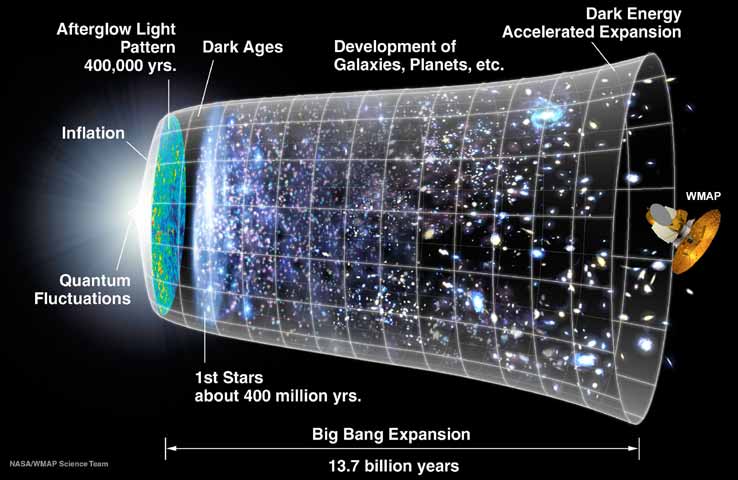
A Star Is Born
However the Universe began, we know it was originally filled with those immense hydrogen gas clouds. As time passed, the hydrogen gas fell in on itself, attracted by its own gravity. As the hydrogen atoms fell together, they heated up and began spinning. The smaller the collapsing clouds became, the faster they spun, just like an ice skater who spins slowly then draws in his or her arms. When the hydrogen gas became dense enough, a fusion reaction was ignited and the new star lit up, radiating heat and light into the Universe.
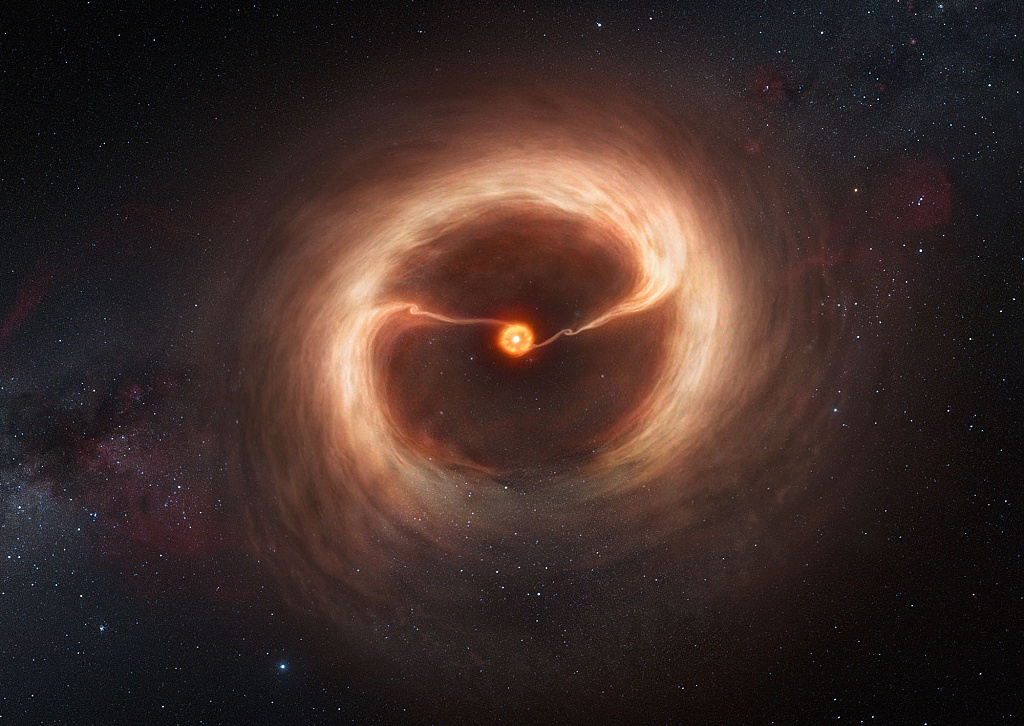
Such a star, one composed of pure hydrogen, is called a first-generation
star.
A first-generation star may include planets—we don't know. If they do, however, such planets would have to be pure hydrogen-gas giants, since that's the only material the star would have to work with.
The hydrogen didn't remain pure for long, however. As a by-product of the fusion reaction, the hydrogen atoms combined—fused, hence the name—and became the next most complicated form of matter, helium.
Fusion has been proven and duplicated, to a limited extent, in the laboratory here on Earth. If we could find a way to create a fusion reaction at room temperature, instead of Sun temperature—cold fusion—we would have all the free energy we wanted.
In time, the helium also began to fuse, producing beryllium; and so on, until
all the elements up through, perhaps, oxygen, had been synthesized. Finally,
depending on the size of the star, it might cease to flame. Without that enormous
amount of outpouring energy keeping it fluffy
, the star collapsed in
earnest—suddenly making one, final burst of fusion possible. In that burst, the
star exploded—we call it a nova—and all the other common but heavier elements, like
uranium and calcium, were created.
The nova burst scattered elements into the heavens; but eventually, the atoms gathered together, forming more clouds that eventually coalesced into new stars. These were second-generation stars, initially formed of all sorts of interesting chemical elements—though, still, mostly hydrogen.
However, at least some second-generation stars form with a retinue of planets around them. Such planets may include gas giants, but can also include planets with rocky or metallic cores, such as Earth, made out of the heavier elements spewed into space by the grandparent nova.
Planets have been found around stars other than our own, by taking
very precise, clear pictures of those stars and then comparing them to earlier
pictures. The gravity of a gas giant planet (like Jupiter) causes its star to
wobble
as the planet whirls around, much as you would if you held
a child's hands and whirled him or her around you.
It may be that something about the way materials coalesce around a forming star, causes smaller, rocky planets to form near the star, with giant, gaseous planets farther out. At least, that's the way it happened in our solar system.
Rock and Roll
We have sent robotic emissaries to most of the planets in our solar system, and Humans to Earth's moon. Everywhere we look, we see evidence of a very violent beginning to our solar system.

Mercury, the moon, and Mars are the only nearby worlds without thick atmospheres. On all three, we see evidence of massive meteoric cratering. In other words, at some time in history, the surfaces of these worlds were peppered by enormous rocks falling from the sky. We see the same thing on the surfaces of the moons of the outer planets, as well.
Even Earth is not immune. Hudson Bay, the two halves of the Mediterranean Sea, and the Gulf of Mexico, are all too round to be coincidence. They are the water-filled remains of meteoric craters of the distant past.
It makes sense, if you think about it. The cloud
that forms a
second-generation star isn't just hydrogen; it's all kinds of materials. Some of
these materials will have already condensed. With enough time, the sand becomes
pebbles, which become stones, which become rocks, which become mountains. And,
even a grain of sand can make a heck of a hole, if it hits the ground at 100,000
miles an hour!
Some of the explosions were truly awesome, so awesome that rocks were ejected from one planet to another. Just a few years ago, meteors were found in Antarctica that were made of a combination of elements we had previously only found on Mars.
Were the planets' orbits originally circular? We don't know. We do know that now, with one exception, they are. Work done a few decades ago on a Cray supercomputer showed, however, that planets in a system with erratic orbits, tend to have their orbits become more purely circular as time goes by. Knowing this, we may someday be able to determine the age of a planet simply by calculating how circular its orbit is!
Gang of Nine

The first documented Human civilization, that of Sumer, knew about all the planets we moderns recognize, plus one more. However, this knowledge was lost between the years in which Sumer flourished and the Golden Age of the Greeks.
For most of Human history, Humankind has acknowledged five planets in our solar
system. The word, planet, comes from a Greek word meaning wanderer
,
because the planets seemed to wander the night sky,
appearing in a different place each night, unlike the fixed stars that seemed to
move all as one thing.
Greek and Roman cosmology imagined that the stars were painted on a giant ceiling hung over the flat Earth, while the glowing planets flew freely below them.
The Sun and moon, unique because they were clearly disc-shaped and could be
seen during the day, were not counted as planets. The recognized planets were
Mercury, Venus, Mars, Jupiter and Saturn. Everyone knew
that these
planets, along with the Sun and moon, revolved around the Earth.
It wasn't until 1543 that Nicolaus Copernicus figured out that the Sun, not the Earth, was the center of the Solar System, and that the planets therefore orbited it.
In 1687 Isaac Newton formulated his Three Laws of Motion and the theory of gravity
(in Philosophiae Naturalis Principia Mathematica) and successfully used
it to predict the location of the planets. However, as telescopes became more
sophisticated, by the 1700s it became clear that something was wrong with the
theory, because Saturn wasn't quite where it was supposed
to be.

Newton's theory of gravity had taken into account the effects of one planet's gravitational pull on another. The only way the theory could be exonerated would be if another planet, previously unknown, existed and was affecting Saturn's orbit. Measurements of the time were still not precise enough to permit calculating exactly where the missing planet would be; that didn't stop astronomers from looking for it. In 1781, Sir William Herschel discovered it, and the new planet was eventually named Uranus.

However, Uranus didn't quite follow its predicted orbit, either. Mathematicians worked overtime to calculate where this new mystery planet would be, and how much it would have to weigh, if it existed. Once the calculations were complete, telescopes turned to the predicted location and took pictures. Sure enough: In 1846, the planet was found. The Theory of Gravity was again exonerated, and the new planet was named Neptune.

When Neptune also showed evidence of a perturbed orbit, new
calculations were made, and Pluto was found in 1930, the most recent planet added to the
list. However, though Pluto was found—and most people are unaware of
this—Pluto was not the planet that perturbed giant Neptune's orbit.
It's too small, even smaller than Mercury. In fact, although Pluto was considered
a planet when it was first discovered, it has since been demoted to dwarf planet
,
like Ceres in the asteroid belt. Neptune shows evidence of being
perturbed by a much more massive world than Pluto. However, astronomers have not yet
found such a world, though the search continues.
Of all the known planets, dwarf or otherwise, Pluto has the most elliptical orbit…and, relative to its size, the largest moon, Charon. Pluto's orbit is so eccentric, in fact, that during part of it, Pluto comes closer to the Sun than Neptune! When looking at a flat graphic of the Solar System, Pluto's orbit looks like it crosses Neptune's, causing some people to suspect that Pluto was once a moon of Neptune's that somehow broke free. Certainly it is a moon-like object, actually smaller than some of Jupiter and Saturn's moons. However, Pluto's orbit is inclined relative to Neptune's orbit, and never actually crosses it at all.
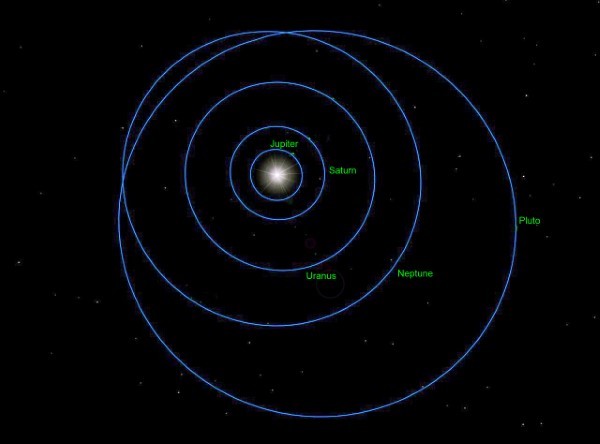
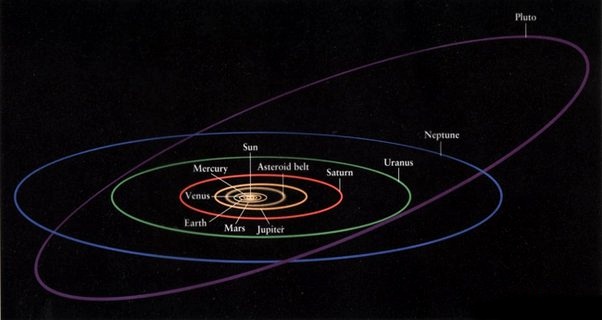
Meanwhile, On Earth…
Once Earth had formed, its radioactive components began decaying at a fixed rate, as radioactive elements do. By measuring the radioactivity of rocks, we can tell how long it's been since the rock solidified, just as we can look at an hourglass and know how long it's been since it was turned over by the amount of sand remaining in it.
Although the surface of the Earth tumbles and turns, with old parts being pushed deep underground and new parts erupting out as volcanic lava, there are a few spots on the Earth where we can find the very oldest rocks. New rocks show evidence of life, as in characteristic pitting from lichens and embedded fossils. The oldest rocks do not. That's how we know there was no (biological) life on Earth when it first formed.
Not that life would have found Earth to be a very hospitable place at first. Hot and noisy with the thunder of volcanoes and lightning, its unbreathable atmosphere was composed of ammonia and methane and its ground shook almost constantly from earthquakes and meteor bombardment.
However, suddenly, about 3.4 billion years ago, in the Swazian era of the Archean period, life suddenly appeared, leaving its mark on the rocks formed then. Not only did life appear suddenly, but there is no fossil record of how it developed before the formation of fully-evolved, if simple, one-celled organisms. It's important to remember that we don't know how the very first life formed, or even if it truly originated on Earth.
That first life, amazingly, was already of a piece: Instead of a vast panoply of competing chemical forms, as seems likely, the fossil record shows that the only life forms in existence were the ones that, eventually, led to us.
Life did originate in the sea. Sea life was already pretty well differentiated (jellyfish and so on) when plant life began to get a foothold on land, about 400 million years ago. It was the plant life, by the way, that changed the atmosphere from ammonia and methane to the oxygen/nitrogen mix we enjoy today. If all plants were to suddenly die, the oxygen would combine with the rocks almost immediately, and the atmosphere would, once again, become unbreathable (at least, to us).
Insects evolved from shrimp-like ancestors, and fish developed. Some fish found a way out of the sea, becoming amphibians (frogs) as part of the journey; later, some amphibians further specialized, and lizards became a fixture of land life.
The Age of Dinosaurs
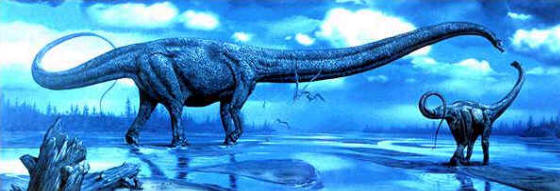
The dinosaurs were not the first land animals, not even almost; but in terms of numbers and longevity, they were the most successful, ever…including now.
Dinosaurs filled every ecological niche in their world, and held them for over 165 million years. (Mammals have been around for nearly 200 million years, but held an extremely minor role in the world's ecology until the dinosaurs disappeared 65 millions years ago; so we have a long way to go before we can challenge the dinosaurs' record!) They weren't all big. Some dinosaurs were turkey sized; some, even smaller. Some grazed in herds, like cows; some hunted on their own, like tigers. There were dinosaurs that swam, dinosaurs that flew, and, possibly, even dinosaurs that thought. The ferocious velociraptor, made famous by the movie Jurassic Park, had a brain the size of ours (much larger than that of most dinosaurs), forward-facing eyes (like ours, which provide three-dimensional vision), and opposable talons that could have allowed them to manipulate tools.
And yet, they all disappeared, abruptly, 65 million years ago. There is overwhelming evidence that a meteor or comet crashed into the Earth, in what is now the Yucatan, in such an incredible explosion that thick clouds of soot and dust and water vapor were thrown high into the atmosphere. These clouds were so thick, and so high, that they totally blocked all light from the Sun for many, many years—causing most plants to die, as well as the animals that ate them. The only species to survive were those that didn't eat much, and could live on the rotting corpses of the ones that didn't. Those were our ancestors, the mammals.
Well, one species of dinosaur survived. In the new world, though, it had to evolve to fit in. That was the ancestor of all of today's birds.
It is possible one other species of dinosaur survived. One of the
sea-going dinosaurs, the Plesiosaur, resembled the fabled Loch Ness monster,
as well as similar monsters
reported in other deep, cold lakes,
such as Vermont's Lake Champlain.
Monkey See, Monkey Do
One of the earliest mammals was a little, squirrel-sized creature that looked something like today's lemur. It had forward-facing eyes, grasping hands instead of claws, and lived on insects. This little, unprepossessing creature, was the first primate…and our ancestor.
Over the next tens of millions of years, this creature evolved into all the various primates of today's world: the monkeys and the apes.
Just as radioactivity breaks down at a clock-like rate, so does DNA drift
from an ancestor form with time. Once fossils have been found and dated (by the
age of the rocks they're in), so that we know when an extinct species walked the
earth, we can find out how fast the DNA clock ticks
by measuring the
differences between two current, related species that the fossil record shows
split back then. Thus, we can determine which species are related to other
species, how closely, and how long ago they diverged.

As great apes ourselves, we are, of course, particularly interested in the ape's lineage. Orangutans split away from the ancestral primates early, about 30 million years ago. The African apes diverged later, about 30 million years ago. Gorillas, and the ancestor of chimpanzees and us, diverged about 25 million years ago.
About 10 million years ago, chimpanzees and the first proto-Humans, called australopithecines, diverged from their common ancestor. They didn't differ much, at first. But, the hominids used tools to a much greater extent. By 8 million years ago, there were, perhaps, ten or twenty different tool-wielding hominid species, amazingly sharing the same, or nearly the same, ecological niches.
But then, about 1.7 million years ago, one of these species stood out by finding a new way to walk, and by creating better tools. We call this species, Homo Erectus: stand-up man. It was the first mammal to rely exclusively on bipedal locomotion. There is also evidence that H. Erectus used fire.
Around 500,000 years ago, the first Neanderthal-type people appeared. Named after a place in Germany where their remains were first found, they actually lived all around the world, In fact, there's an interesting quirk to their development: They seem to have appeared in three different places, far removed from each other, at once.
Their stone tools were far more sophisticated than Homo Erectus', who was still around; but still very primitive—not much more than rocks, really. And their tools didn't change during the next 400,000 years. But then, 100,000 years ago, anatomically modern Humans appeared on the scene.
Were the Neanderthals our ancestors? For a long time, scientists thought so.
However, the latest DNA testing seems to indicate that we are not closely
related at all. I say, seems
, because it's not easy to get a clean
DNA sample from a 100,000-year-old skeleton.
We do know that anatomically modern Humans and Neanderthals continued to live side-by-side for 200,000 more years, without seeming to interbreed, before the Neanderthals went extinct.
Interestingly, the tools of the anatomically modern Humans were, at first, almost identical to those of the Neanderthals. But then, something happened. Somehow, without changing brain size, the anatomically modern Humans got smarter. Previously, a tool might be used for 100,000 years or more without change. Now, tools were improved every 10,000 years…and then more frequently. Finally, about 6,000 BCE, man suddenly developed farming, animal husbandry, art, and urban civilization…all at once.
Super Sumer

That first civilization was called by its inhabitants, Sumer
(actually pronounced, Shumer
). These sophisticated people invented, in
addition to the technologies listed above, metallurgy, astronomy and astrology,
literature, the calendar, wine and beer, writing, and government. Their written
word was impressed upon clay tablets, hundreds of thousands of them, which have
survived and been translated. It turns out that the early books of the Hebrew
Bible are actually Sumerian tales, with the Hebrews' Yahweh replacing the
Sumerian gods of the originals.
The Sumerian gods, in fact, were the Sumerians' biggest export. By matching traits, names, and tales, scholars have determined that the Sumerian myths became the myths of Babylon, the Indus Valley, Egypt, Phoenicia, Greece, and Rome, as well as of Israel.
The Sumerians knew of all nine planets (plus one more); their calendar was more accurate than the one we use today. They knew of the precession of the equinoxes (caused by Earth's wobble as it rotates). They knew the Earth was round, that it was a planet like the others, and its correct position in the solar system.
And yet, through the centuries, Sumer's great knowledge became diluted and,
largely, lost. By the time of the Greeks, just two thousand years later, most
people thought the Earth was flat and that there were just five planets. A
thousand years later, and the Roman calendar was so inaccurate that periodic,
non-calendar festivals
had to be held to try and bring it into sync
with the Sun. A thousand years after that, and we experienced the height of the
Dark Ages, when most of Humanity couldn't read or write and many, many books
were lost…a period from which we are, only now, beginning to recover.
Enter Scientific Method

What saved us was the introduction, around two hundred years ago, of what we
have come to call scientific method.
This is a discipline in which
nothing is said to be true unless it has actually been observed to be
true…and, even then, it must be repeatable so that anyone can prove to
themselves, that the observation is real.
Prior to scientific method, the most preposterous claims were taught as fact:
That life could arise from garbage, that illnesses were due to ill humours
in the body, that space was filled with a thin liquid called ether. None of
these claims had ever been verified, but, before scientific method, they
didn't have to be. Anyone who was wealthy or well-placed could make any claim at
all, and it would be accepted without question by the masses.
Scientific method changed all that. Thanks to this discipline, we began to rediscover some of the things the Sumerians had known: The nature of diseases and how to cure them, the workings of gravity and electricity and chemistry, the existence and uses of invisible radiations such as X-rays and radio waves.
Scientific method also has its downside. By its nature, it only applies to
repeatable phenomena. Inherently one-shot events—like the appearance of a ghost
in your house, or a precognition of danger—cannot be studied directly by the
scientific method. Unfortunately, some people who call themselves
scientists
have confused events which cannot be repeated, with
events that cannot happen at all. There were people who held onto
false-but-comfortable beliefs before scientific method came along, there are
such people now, and there will probably be such people when we have shifted
over to the next paradigm, whatever that may be.
Just remember, there is a difference between being unscientific—misusing
scientific method—and being non-scientific
, that is,
studying non-repeatable phenomena to see if there isn't some aspect of the
phenomena that can be repeated, some information that can be
obtained and verified.
And so, we come to the end of this essay. I have tried to provide a brief framework in which you can fit the speculations that are to follow. Remember, to the best of our knowledge, the facts presented above have been proven. While it is possible—even likely—that more detail will follow, the outline presented has continued to fit the facts for long enough to be accepted by just about everyone with the knowledge to do so. Every fact presented is something you can study and verify for yourself—that's what scientific method is all about!
In times past, we were presented with Authority: priests, teachers, and kings, who toldus what was so and permitted no questioning. Often, the authorities were wrong; and poverty, illness, and war was the result.
Scientific method makes it possible for us to be our own authorities. We can keep ourselves informed in any subject in which we are interested. Now, if we simply accept the word of any scientist, without question, we will find no improvement from before. We will simply have replaced one authority with another. But, we Humans have the ability to become a species of scientists. By using the scientific method, we can verify, for ourselves, that what is so, is so; and what is not, is not. We can, personally, understand what the limits are for scientific method.
And, one of us may, in the near future, synthesize the next paradigm, the one that will evolve from scientific method, and enable us to study, even more reliably, the non-repeatables, such as personal consciousness, good and evil, God, and the existence of the soul.




